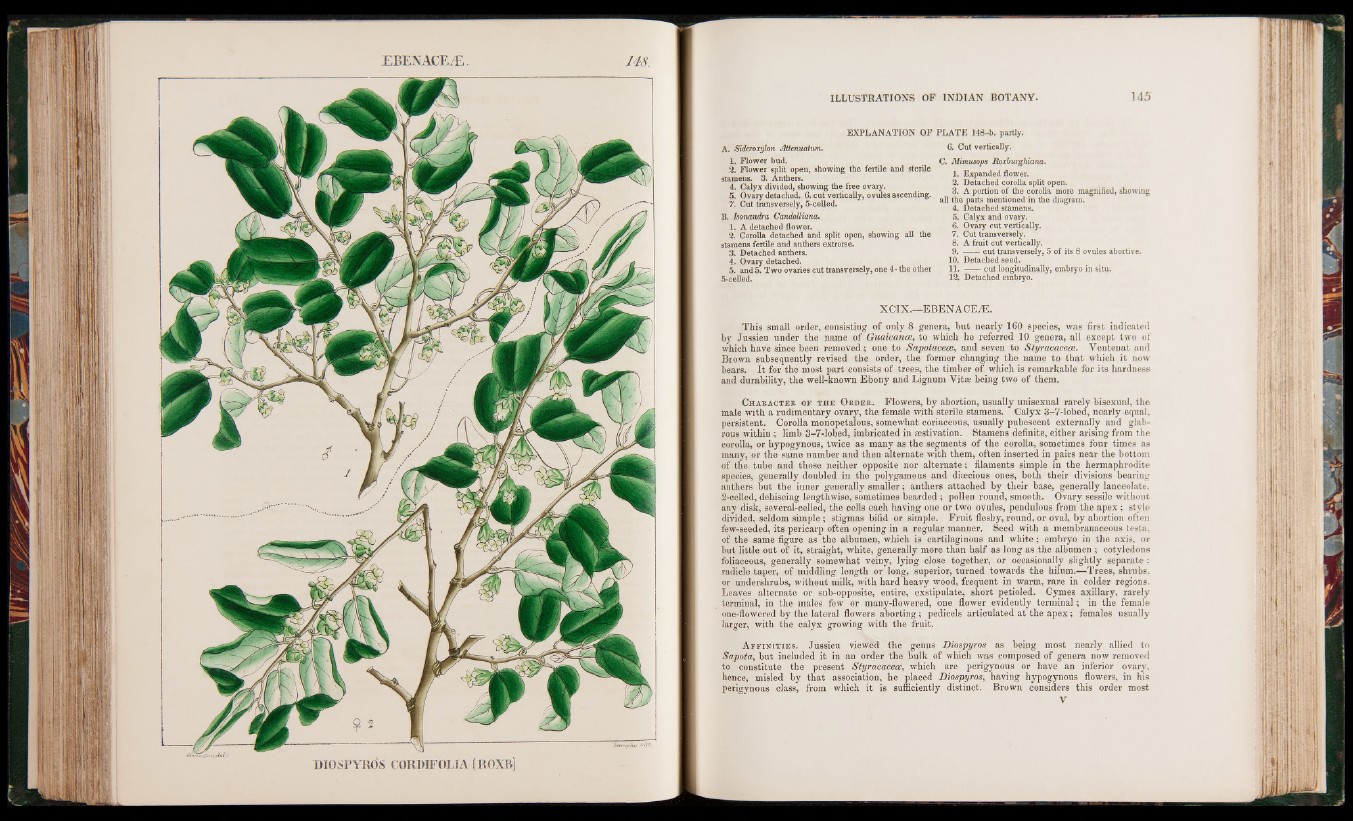
EBENACEÆ 148.
DIOSPYROS CORPIFOLÏA I KOXB,
EXPLANATION OF PLATE 14&-b. partly.
A. Sideroxylon Attenuatum.
1. Flower bud.
2. Flower split open, showing the fertile and sterile
stamens. 3. Anthers.
4. Calyx divided, showing the free ovary.
5. Ovary detached. 6. cut vertically, ovules ascending.
7. Cut transversely, 5-celled.
33. Isonandra Candolliana.
1. A detached flower.
2. Corolla detached and split open, showing all the
stamens fertile and anthers extrorse.
3. Detached anthers.
4. Ovary detached.
5. and 5. Two ovaries cut transversely, one 4- the other
5-celled.
6. Cut vertically.
C. Mimusops Roxburghiana.
1. Expanded flower.
2. Detached corolla split open.
3. A portion of the corolla more magnified, showing
all the parts mentioned in the diagram.
4. Detached stamens.
5. Calyx and ovary.
6. Ovary cut vertically.
7. Cut transversely.
8. A fruit cut vertically.
9. ——- cut transversely, 5 of its 8 ovules abortive.
10. Detached seed.
11. ; — rr- cut longitudinally, embryo in situ.
12. Detached embryo.
XCIX.—EBENACEjE .
This small order, consisting of only 8 genera, but nearly 160 species, was first indicated
by Jussieu under the name of Guaicance, to which he referred 10 genera, all except two of
which haye since been removed; one to Sapotacece, and seven to Styracacece. Ventenat and
Brown subsequently revised the order, the former changing the name to that which it now
bears. It for the most part consists of trees, the timber of which is remarkable for its hardness
and durability, the well-known Ebony and Lignum Vita? being two of them.
Character of the Obder. Flowers, by abortion, usually unisexual rarely bisexual, the
male with a rudimentary ovary, the female with sterile stamens. Calyx 3-7-lobed, nearly equal,
persistent. Corolla monopetalous, somewhat coriaceous, usually pubescent externally and glabrous
within ; limb 3-7-lobed, imbricated in «estivation. Stamens definite, either arising from the
corolla, or hypogynous, twice as many as the segments of the corolla, sometimes four times as
many, or the same number and then alternate with them, often inserted in pairs near the bottom
of the tube and those neither opposite nor alternate; filaments simple in the hermaphrodite
species, generally doubled in the polygamous and diaecious ones, both their divisions bearing
anthers but the inner generally smaller; anthers attached by their base, generally lanceolate,
2-celled, dehiscing lengthwise, sometimes bearded; pollen round, smooth. Ovary sessile without
any disk, several-celled, the cells each having one or two ovules, pendulous from the apex ; style
divided, seldom simple; stigmas bifid or simple. Fruit fleshy, round, or oval, by abortion often
few-seeded, its pericarp often opening in a regular manner. Seed with a membranaceous testa,
of the same figure as the albumen, which is cartilaginous and white; embryo in the axis, or
but little out of it, straight, white, generally more than half as long as the albumen ; cotyledons
foliaceous, generally somewhat veiny, lying close together, or occasionally slightly separate;
radicle taper, of middling length or long, superior, turned towards the hilum.—Trees, shrubs,
or undershrubs, without milk, with hard heavy wood, frequent in warm, rare in colder regions.
Leaves alternate or sub-opposite, entire, exstipulate, short petioled. Cymes axillary, rarely
terminal, in the males few or many-flowered, one flower evidently terminal; in the female
one-flowered by the lateral flowers aborting; pedicels articulated at the apex; females usually
larger, with the calyx growing with the fruit.
Af f in it ie s . Jussieu viewed the genus JQiospyros as being most nearly allied to
Sapota, but included it in an order the bulk of which was composed of genera now removed
to constitute the present Styracacece, which are perigynous or have an inferior ovary,
hence, misled by that association, he placed Diospyros, having hypogynous flowers, in his
perigynous class, from which it is sufficiently distinct. Brown considers this order most
y